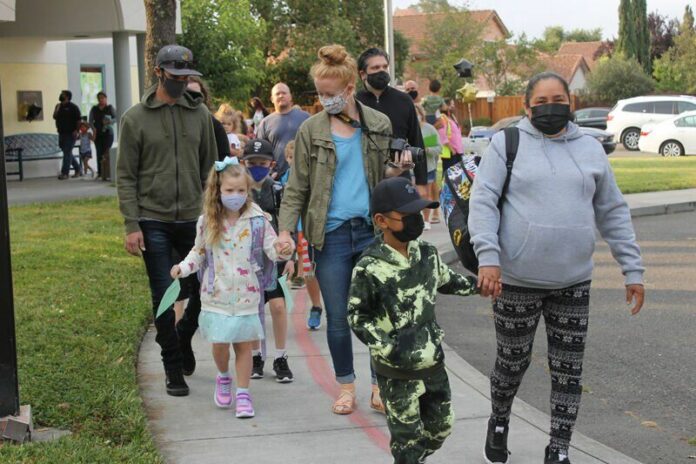Over winter break, Pete Sullivan, the Windsor Unified School District’s director of COVID mitigation, was looking at nearly as many active cases in Windsor High School students as he’d seen the entire fall semester. Twenty-eight high schoolers had confirmed, positive cases in the last week of 2021, compared to a total of 31 cases between September and December, with the high being a week with 16 active cases at once last fall.
Twenty-eight cases, however, is nothing compared to the district’s total current 438 active cases.
Since schools reopened Jan. 3, COVID-19 cases among the district’s student and staff populations have been skyrocketing to unprecedented heights. As of Jan. 14, Sullivan said there were 387 active cases among the district’s 4,664 students, and 51 cases among its approximately 540 full-time staff. That means 8.3% of Windsor students and 9.4% of staff are currently positive for COVID-19 — and that’s only the confirmed cases.
The high rates within the school district mirror broader local, nationwide and global trends of increased transmissibility caused by the highly contagious omicron variant, although the rates within the district are substantially higher than in the general population.
Windsor continues to have one of the highest active case rate per capita in Sonoma County, with 1,064 active cases, meaning 4% of Windsor’s 26,344 residents are currently positive for COVID-19 as of Jan. 14. Controlled for population, Windsor has an active case rate of 3749.5 per 100,000 residents.
Looking at Sonoma County as a whole, active cases more than tripled in one week this month, with 4,181 cases county wide on Jan. 7 and nearly 14,000 on Jan. 13, an increase from just under 1% to just under 3% of Sonoma County’s 488,863 residents.
And while the Sonoma County Health Officer has released a slew of new health orders, including limiting large gatherings to 100 outside and 50 inside, lockdowns have not returned at either state or local levels, and Sullivan said schools are unlikely to head back into lockdowns. Rather, Windsor families are likely to see a progressive relaxation on certain WUSD COVID-19 mitigation protocols.
Sullivan said this is because the virus is becoming endemic, meaning it will be less severe and more tolerated by humans.
“We’re on year two of this, and we’re handling the cases differently now. This variant appears to have less of an impact in terms of severity,” Sullivan said. “There is concern about COVID infection, but I think there is also a realistic view of what this particular variant is bringing to us. Nobody wants to get COVID, nobody wants to spread COVID, but I think we’re starting to understand we’re approaching an endemic phase. It’s an acceptance of what’s going to be. We’re going to have to live with this,” Sullivan said.
Backing up Sullivan’s assertion that the omicron variant has less severe outcomes, Sonoma County data shows that while cases in December 2021 were higher than in December 2020, the county lost only six people to COVID-related deaths last month, less than a fifth of the number of deaths in the same month a year prior, when the county lost 32 people.
In a Jan. 2 letter, Superintendent Jeremy Decker assured parents that omicron posed less of a threat to health than previous variants, citing lower hospitalization rates than months earlier when cases were lower.
WUSD takes its lead on COVID-19 from the Sonoma County Office of Education (SCOE), which operates based on county and state level health mandates. Sullivan said there is currently no plan to close schools because of the surge, and schools are actually changing their response to COVID-19 to prevent a separate but related educational obstacle that has plagued the students and families: protracted absences.
“Education is vital, and the support services we provide kids here they can’t get anywhere else. If we close, those kids go without those services. We think it’s just very important that our kids and families continue to get these services. Unless the county is telling us to close, we’re going to do our best to stay open,” Sullivan said.
Since schools reopened at the end of the 2020-21 school year and until the start of this spring semester, schools in Windsor and Sonoma County had quarantine and isolation requirements that sometimes resulted in students or staff being absent for periods of 20 days, as they were based on exposure, not a positive test or the presence of symptoms.
“In the old method, if a student was in a home with a positive person, their quarantine started on the last day of exposure. They would be out for 10 days if a relative had it and then another 10 days,” Sullivan said.
Similarly, Sullivan, who started in his role as director of COVID mitigation at the start of this school year, would work with teams at each site to identify all of the students who could have been exposed with each reported positive case, resulting in family notifications and 10 days of either quarantine at home or modified quarantine in which they could still attend class but no extracurriculars.
Windsor schools are now approaching things differently. In what he called the “group tracing approach,” Sullivan said the district, under SCOE guidance, is now recommending that, after exposure, asymptomatic students stay in school regardless of their vaccination status, whether they have had a prior infection or whether they were wearing masks at the time of exposure.
Now, all exposed students and staff will be required only to continue to wear masks, check for symptoms and test on days three and five after exposure. Barring symptoms or a positive test, no quarantine is required, limiting the number of days students and staff are out of school needlessly for simple exposure.
“It’s a huge change,” he said. “That’s a massive change in the step of accepting this is going to be around us. We’re moving toward the endemic phase where we have to make these adjustments — we have to be able live with COVID-19.”
While nearly 10% of staff are currently out with COVID, Sullivan said the district has been able to maintain operations through its preemptive hiring of full-time substitute teachers to cover for sick teachers. Other faculty are also helping cover for sick colleagues by taking over their classes during their prep periods, so Windsor schools are unlikely to close from lack of staff, like two West County schools were forced to on Jan. 14; however, having so much staff out is still less than ideal.
“Teachers are tired right now, but our teachers are really stepping up and it’s been awesome. Our substitutes and staff have done a tremendous job in covering for each other and being here for the kids, but there’s inconsistency when you have teachers out,” he said.
Sullivan emphasized that he is not dismissive of the risk posed by COVID-19 and cited 409 community members coming to a district testing site for COVID-19 tests on Jan. 10 as indicative of persisting community concerns. WUSD will continue to follow state and county guidance and incorporate other mitigation efforts to prevent transmission as much as possible.
For instance, all California students received state test kits with two at-home tests each to conduct survey testing. Windsor schools had students take the first test Jan. 9, with the second scheduled for Jan. 18.
The district has COVID mitigation teams at each school site to help isolate students showing symptoms until they can be tested at the district’s testing site, which rotates daily between five campuses. But Sullivan said his team is working to supply each WUSD school site with rapid antigen tests, which are less likely than PCRs to show positive results when an infected person is no longer contagious.
The district has purchased KN95 masks for all staff, providing surgical masks to students, and the hopes to reopen vaccine and booster clinics when more shots become available. Sullivan also sends weekly video updates to WUSD parents to inform them of changing protocols.
Other COVID mitigation efforts include requiring indoor and outdoor masking, providing outdoor dining options, utilizing air scrubbers in classrooms and offering independent studies as an option for concerned families.
“We have to have some sort of sustainable mitigation procedures like what you have with other illnesses,” Sullivan said









